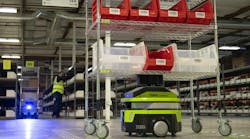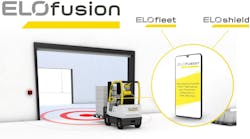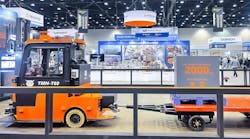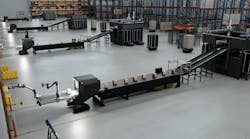Simplify Robot Installations With RobotStudio
RobotStudio AR viewer provides a quick and convenient way of visualizing where and how robotic automation can fit into your process using a smartphone or tablet. The RobotStudio AR Viewer app can be used to test any model created in RobotStudio, enabling users to get an idea of the size and scale of a robot or robot cell and how it can be deployed on a factory floor to fit around any existing production equipment. Using AR technology, the app overlays the modeled solution into the real-life production environment, with the ability to scale it to full size and rotate it through a variety of angles to achieve the best result.
The benefits of the AR Viewer extend to being able to watch the model in action. A timeline feature makes it possible to check the cycle time and go quickly to a certain point in time in the animation, enabling you to find ways of enhancing performance or pinpointing a potential issue.
Available free of charge on the Apple Store and Google Play Store and viewable on any compatible smart device (from iPhone 6s, iPad Pro or onwards and Android 7.0 onwards with ARCore support), the app provides a low cost, safe and easy way of visualizing an installation that can be used by individuals or groups, with none of the potential concerns over complexity, hygiene or nausea that can occur with VR-based alternatives.
The AR Viewer is ideal for companies that are new to robotic automation, or for those who have previously lacked the time or resources to start to plan an installation.
UPDATE (2/2021):
ABB's RobotStudio offline programming and simulation software has been upgraded with a new virtual robot braking distance function designed to create an exact simulation of the real-world stopping distance of a robot. Enabling the robot’s braking distance to be accurately calculated, the function overcomes the need to add safety margins into cell designs, enabling space savings of up to 25%.
Predicting exactly where a robot will stop depends on a range of variables including speed, payload, and the robot's own inertia. These factors, individually or combined, can result in the robot coming to a halt outside of its safety zone, sometimes by several meters. To compensate for the variability in stopping distances, engineers designing robot cells traditionally oversize them to allow for additional movement as the robot comes to a stop, which uses unnecessary space on the factory floor.
The RobotStudio function uses ABB's superior motion control technology to predict the robot's movements with millimetric precision. This allows the exact movement of the robot to be simulated in RobotStudio, enabling the user to determine the correct size of the safety zone required, and the ideal location of features including light curtains, safety fencing, and controllers.
For applications using ABB's SafeMove software, the data on the robot's final position can be used to determine the size of the 'green,' 'amber', and 'red' zones where the robot will either continue working, slow down or come to a halt, depending on the location of the operator. This is especially beneficial in collaborative applications where operators need to be confident that a robot has stopped before approaching it.
- Virtual Meetings: A collaboration feature allowing to share the digital robot solutions in web meetings. The participants are immersed in the virtual room, using a VR headset connected to RobotStudio, where the RobotStudio station can be shared for making design reviews and sales proposals without traveling?
- Digital Twin: A concept to monitor and optimize the automation solution without disturbing the ongoing production. It enables real-time simulation of the production system, like a digital shadow, allowing the users to try changes and do optimization in the virtual world without affecting the production.?
- Virtual Commissioning: ABBs virtual commissioning solutions speed up commissioning by simulating an exact replica of the production cell in RobotStudio so that all technical issues can be solved in advance. RobotStudio allows connecting to PLCs and other external devices to fully virtually test the complete logic and safety of the cell prior to installing the physical line.?
- Augmented Reality: By using Augmented Reality (AR) technology, you can visualize robot solutions by overlaying the modeled solution over the real-life production environment as a hologram. This is done by visualizing simulations created in RobotStudio through or by using our app on a smartphone or tablet?.
- Stop Position Simulation?: A feature that visualizes the optimal braking distance. It simulated the stop position of the robot with millisecond precision for easier use of SafeMove, reduced footprint of cells, and for faster and more effective virtual and physical commissioning?





